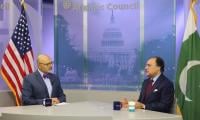“Social pathologies can be understood as forms of manifestation of systematically distorted communication.” — Jurgen Habermas
Pakistan is witnessing an alarming increase in the number of the polio cases as the tally has now risen to 80.
Although certain social factors have contributed to this sorry state of affairs, low literacy rate, the prevalence of unscientific reasoning and belief in conspiracy theories and the lack of an effective communication strategy are some of the challenges Pakistan is facing to eradicate polio.
The national polio eradication initiative was launched in 1994 with little focus on the cultural dynamics and peculiar knowledge associated with the local psyche and customs. The policy-makers seem to have never grasped the wisdom of renowned communication theorist Everett Rogers who maintained that any “innovation” in a new set-up is bound to show meagre impact if not integrated to the indigenous ways through effective “channels.” Thus, it will rarely become part of what he calls the “diffusion process.”
As a corollary, the programme implementers find themselves struggling to overcome the crippling menace. For instance, it was a communication failure that the planners were unprepared to counter the propaganda against polio vaccination. Due to lack of “crisis communication” mechanism in place, the programme failed to effectively respond to the emergency situation that broke out in Peshawar on 22nd April this year. It dealt a serious blow to the initiative and necessitated a deeper look into the ongoing predicament.
First, the programme’s main emphasis is on data collection which has reduced it to abstract numbers as they fail to develop a concrete link in human terms or help in comprehensive policy-making. Like little knowledge, scrappy statistics could be perilous and too much reliance on them could jeopardize the eradication initiative.
The obsession of the policymakers with quantification of statistical tables and categories misses out on the real picture of what is happening on the ground. Their implicit idealism leaves them unwarranted in comprehending the social and psychological impediments that stand in the way to vaccinate all children.
Second, there is a cacophony of discord and confusion at the policy-making level due to the overlapping structure of the public-private partnership. It would be no exaggeration to say that the programme quite aptly resembles the proverbial “Tower of Babble.” In the prevalent model of UN-Government partnership, key state institutions like district administration and health department have taken backseats whereas partner agencies play the first fiddle. This constructs parallel structures and ensues in confused roles on the part of polio workers by transmitting mixed messages from multiple quarters.
Third, our education centres do not lay added emphasis on the significance of public health and the civic spirit that accompanies it. Since education is a means of forming collective consciousness, both the public as well as private educational institutions can prove instrumental in the implementation of an inclusive polio eradication strategy. But the state has not optimally engaged the educational institutes in creating awareness regarding the polio immunisation or combating non-compliance about the prevalent misconceptions. Moreover, the curriculum of medical institutes including public health schools does not shed light on the significance of polio eradication or sufficiently motivates the students regarding this vital aspect.
Fourth, the initiatives within the programme like “Polio Plus” and “Integrated Services Delivery” have not been effective in winning the hearts and minds of the people. They imply a special meaning with a focus not only on vaccine-preventable diseases but also bringing other health benefits like better nutrition, access to clean water, improved sanitation and waste disposal. However, they have not been vigorously reinforced along with the immunisation activities and therefore the general hygiene standards in most of the urban and remote localities remain deplorable. Due to the deficiency of basic civic facilities, sole emphasis on vaccination leaves the masses further sceptical about the programme.
Society, as Prof. Toynbee famously remarked, is the interplay of challenge and response; its success or failure rests on its ability to creatively respond to the various challenges that confront it. Honest efforts are already afoot regarding the new communication strategy. However, considerable efforts need to be made on all fronts simultaneously if positive results are to be achieved. At the threshold of these challenges, it is inevitable to come up with a holistic paradigm shift.
It is imperative that the programme should not be left to statistics and magical numbers alone. Rather the data needs to be utilised as a form of communication strategy applicable to an in-depth study of the human mind and social relations. It can be of normative value and used as an effective decision-making tool only if it helps in the understanding of complex cultural patterns and their correlation to the existing policies. Instead of being merely abstract and symbolic it should give concrete and coherent insight into human behaviour and social realities.
In addition, let’s also not forget that too many cooks only spoil things. There is a need to abolish the parallel structural overlap which would not only usher in a uniform policy but also define clear roles and responsibilities of all those linked to the programme. Further, the ceremonial role of the health department and deputy commissioner at the district level needs to be enhanced as it will help in the vigorous implementation of operational objectives. Let’s be clear that the partner agencies can only lend a technical role while mainly it is the government ownership that will prove decisive in steering the programme to its logical end.
Further, the new communication strategy should aim at making the public as well as private educational institutes as leading avenues of greater social interactivity and getting rid of false perceptions. There is a need for interactive sessions as well as awareness programmes in a more vigorous and sustained manner. Polio must be made part of the school curriculum and plays and stage dramas need to be presented to highlight the ordeals of a crippled child.
This will impact the children’s minds as they are most impressionable in imbibing new ideas and influences. A further positive outcome of this could be the sensitization of resistant parents.
Last but not the least, alongside the essential immunisation there is a dire need to enhance the habitation of local communities through better sanitation, disposal of sewage, improved water supply, and provision of nutritional and health services. This strategy has effectively worked in the Nigerian city of Kano and India’s Dharavi slums where immunisation efforts ultimately succeeded due to intervention in other key areas.
Once such a holistic public health programme becomes the responsibility of the government, hearts and minds of the people could also be won. This will also prove instrumental in restoring the confidence of the masses in the programme. Otherwise, raising expectations and not delivering them only fuels cynicism and mistrust and could render the dream of polio eradication a hopeless quest.
The writer is a civil servant
This initiative aims to address the needs of patients who are unable to seek medical assistance during regular working...
Now stranded at the airport, these passengers face difficulties and uncertainties as they await assistance
Ashrafi also highlighted the efforts of prime minister and army chief in garnering support and commitments from key...
Former commissioner Rawalpindi has submitted the lawyer’s letter and his answer in the court
Establishment Division issued a notification regarding appointment of new Secretary Health
In a statement released to the press, the association declared its decision to halt the supply of petroleum products...







